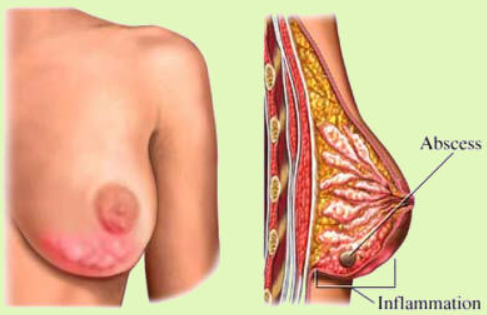
A breast abscess is a common condition where a cyst fills up with fluid and becomes infected. It is usually accompanied by swelling, heat and pain to a localized area on the breast. If antibiotics are unsuccessful in treating the abscess, the doctor may have to drain it with a surgical procedure to promote healing.
Women in the 18 to 50 year age range often experience breast abscesses. 1 in 10 women who are breastfeeding get an infection known as mastitis. About 3% of these women, despite antibiotic treatment for mastitis, develop breast abscesses. This article contains information to help you recognize symptoms, what causes it, and what treatment is available. As always, if you experience symptoms it is important to contact your physician for advice.
Causes of Breast Abscess
The most common cause of a breast abscess is an infection known as mastitis. This infection causes the breast to become inflamed and leads to a breast abscess. Things that cause inflammation of the breast include:
- Breastfeeding and blockage of the milk ducts. This also includes breast engorgement in women who have decided not to breastfeed and shortly after birth the milk comes in but there is no let-down of milk produced.
- Infection in the breast due to bacteria entering milk ducts i.e. nipple piercings, dry cracked nipples, etc.
- Smokers can get periductal mastitis (cigarette smoke damages the ducts near the nipple)
- Bacterial overgrowth in the milk ducts whether breastfeeding or not
One important note is that breast abscess is most often seen in breastfeeding mothers, but studies show that they are increasing in non-breastfeeding women. The cause of this is the increase may be attributed to MRSA or methicillin resistant staphylococcus aureus infections.
Signs of Breast Abscess
Breast abscesses begin by the breast tissue becoming inflamed. The inflammation is known as mastitis. At this stage, you may have pain and swelling in the breast. Some women even run a low-grade fever. Other symptoms include:
- Itching around the nipple area or the abscess itself
- Tender nipples
- Breast engorgement
- Discharge from the nipple
- Enlarged lymph nodes
After a short period of inflammation, the infection becomes “full-blown” and symptoms increase. You may have a green, yellow discharge that flows out of the nipple or actual abscess. You may begin to feel generally sick and your fever may increase. Since this is a bacterial infection, your body will begin to send white blood cells to fight off the infection. The tissue around the infection becomes hardened and forms a lump called an abscess.
When to See aDoctor
The breast infection that causes a breast abscess is most often staph. This can be very serious if the bacteria enter the bloodstream. If you experience tender breasts, redness, swelling, or feelheat, swollen lymph nodes under your armpit, you need to see a doctor right away.
You need to call 911 or go to your nearest emergency room if you have any of the following:
- Fever over 101°F
- If you lose consciousness or are confused
- If you faint
- Lethargy
- Low output of urine
- Trouble breathing
- Rapid breathing
These are symptoms of a bloodstream infection known as sepsis. Sepsis can cause multi-organ failure and severe complications.
How to Deal with Breast Abscess
Breast abscess treatment depends on the level of infection and how large the abscess is. Your doctor will take a history from you, check your vital signs and possibly order tests. Then you may have the following treatments.
Small Breast Abscesses
For a small abscess the doctor will most likely put you on antibiotics. If you are breastfeeding, you should continue to breastfeed to keep the milk flowing through the ducts. The infection will not hurt your baby.
Large Breast Abscesses
For a large abscess the treatment is pretty much the same as for a small abscess. The doctor will put you on antibiotics and encourage you to breastfeed. In addition, you may need to have the abscess drained. They do this with an ultrasound machine and small needle inserted into the abscess to pull off excess fluid.
Regardless of how large the abscess is, it is very important to finish all antibiotic treatment even if you feel better and the abscess shrinks in size. This prevents the bacteria from becoming resistant and causing a more severe infection.
How to Prevent Breast Abscess
- If you are breastfeeding, make sure you are breastfeeding on schedule and try not to skip any feedings. This will prevent blocked milk ducts and bacteria build up. If you already have an abscess, continue to breastfeed to keep the milk flowing through the ducts. This will not hurt your baby. If it hurts to breastfeed, use a good quality pump to drain the milk from your breast and feed your baby off the breast that does not hurt.
- Keep the skin around your nipples clean and dry to prevent bacteria.
- Use a good moisturizer on your nipples to prevent cracking.
- Massage your breasts gently but firmly.
- If you recently had a baby and have decided not to breastfeed, your breasts may become engorged. To relieve pressure, get into a hot shower and let the water run over your breasts to help them let-down some milk.